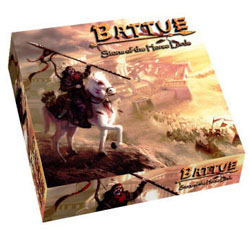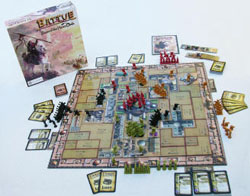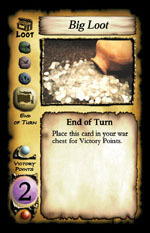
|
About OgreCave and its staff
|

|
by Lee Valentine
Battue: Storm of the HorselordsPublished by Red JuggernautDesigned by Jim Long $50.00 This game was a runner-up for Best Boardgame in our Ogre's Choice Awards 2008
Battue is a boardgame release by new game company Red Juggernaut. Battue's theme is a simple but exciting one that is rarely tackled in the gaming industry: Mongol horsemen sacking a Roman city.
The World of Terris We are first introduced to the world of Terris in a two page fictional account of the back story of Battue at the beginning of the worldbook. Battue means "the hunt", in the language of the Horse Lords of Terris. In short, the death of a great leader has left a power vacuum which will be filled by the new Khan of Khans of the Horse Lords who will prove himself by leading the Golden Horde to sack the Zanatine (read "Roman") city of Tarsos.
Gameplay The city of Tarsos changes every time the game is played because of the tile setup. The Palace of Tarsos is represented by a large tile which is always put in the same place – the center of the board. The walls, towers, and gates of the city are printed directly on the board. Within the walls and around the Palace players build the city itself by placing a selection of tiles face down, until the interior of the board is covered with tiles. There are more than enough tiles so that the map is different each time. In addition to the Palace, Templum Minerva, Templum Jupiter, Universitas, and Schola are four tiles which must always be used. The two school tiles share the same shape. The two Temples are also shaped like each other. The goal of the game is to amass Victory Points by looting and controlling a significant section of Tarsos. The game ends when only one player's hordes remain or when the Palace, Templum Jupiter, and Universitas are all controlled (by any combination of players). Since the tiles start face down, the temple tiles are all the same shape, and the school tiles are all the same shape mean that it's difficult to immediately race for the three game-ending spaces. On a player's turn he can recruit new warriors to his hordes or move and attack sections of the city. Recruitment adds a random number of warriors (determined by a roll of 1D3). Movement simply moves a horde of warriors to an adjacent tile and flips that tile face up.
If you succeed in an attack against an uncontrolled tile then you gain control of it. Otherwise, in the case where there are opposing warriors on each side, the losing side loses a single warrior and the battle may continue or either side may retreat to an adjacent territory that they control. Like in Risk, you can split your single horde into multiple smaller hordes and grow each horde individually, to a maximum of eight warriors in a horde, and a maximum of 15 warriors on the board for a single player. Unlike Risk, however, you don't have to leave a single unit behind to claim control over a map area. When a player gains control over a map tile, he literally plants his flag there and keeps that tile's Victory Points until someone else uproots him from the tile. Initially each player starts with a single horde off the board and aims their horde at a city wall, gate, or tower space printed on the board. Since each player picks a different board edge to start on, all initial battles are against uncontrolled tiles. Really bad luck combined with a lack of familiarity with the game can result in a Traveller RPG-esque death by dice, and punt a player right out of the game before he even gets his warriors on the board. This is more likely when a player tries to enter via the Tower (defense 6) than the Gate (defense 3). In the simulations I ran, I found that a relentless attempt at entering through a Tower space could eliminate you from the game around 45% of the time on your first turn, while the same posture taken against a gate would leave you with at least one remaining warrior close to 100% of the time. The rulebook also says that you can't retreat unless you control a space on the board, but the FAQ file softens this rule by also allowing players with a failing entry attempt to abort it temporarily, recruit more forces, and try again on a subsequent turn. This was an important omission from the rulebook, but it thankfully made it into the game's FAQ. None of us tried a tower entry in our games, so even with this omission, none of us were eliminated before we made it onto the board. Clearly, players who have read the FAQ and aren't taking suicidal risks won't face elimination, but could still limp onto the board with a much smaller single horde. Tougher tiles grant you more Victory Points to help you win the game, but they only count for you if you continue to maintain control of those tiles until the game's end. The dicing mechanic described above is noteworthy. Because ties go to the defender, and because a player in control of a tile adds its innate defense to his defensive rolls, being an attacker in this game is an uphill battle. Being an attacker, however, is the primary tactic of the game. So how's a fellow to win around here? As fortune would have it, there's a way that the attacker can partially subvert the dicing mechanic to his favor – Loot cards.
In addition to Loot cards there are Event cards. When a player flips a really important city tile he may be forced to draw an Event card. Note that you only have to flip an important tile, not win it, to get an Event card. Event cards are generally good, but sometimes bad. Played immediately, Event cards add a bit of randomness to the game, to shake things up before you can attempt to take an important tile. With one exception, all these cards are quite easy to understand and use, but add a lot of the game's deeper tactical play options. While none of them were particularly hard to understand, some of them are wordy. One card is over 100 words long, but understandable and pretty trivial to implement. However, this may initially scare some non-gamers or Eurogamers looking at the game.
For First Time Players The potential for early elimination was of great concern to me. While in the long run, players will learn what helps them win and what gets them killed, a cunning opponent could eliminate a first time Battue player with little or no warning. For instance, if you don't keep all your early warriors in a single horde it's more dangerous to take some tiles. However, if you do put all your eggs in a basket, some loot cards played by a player with even one more warrior than you can eliminate you from the game in the first ten minutes. That's why I give Battue two playability ratings below. Battue will make some unlucky players very unhappy during their first game, but after learning the tricks of the trade, player survivability will rise substantially in subsequent replays. To avoid some of the negative surprises during your first play, let everyone review all the Event and Loot cards before they play that first game. Battue has, in my opinion, exceptionally high replay value, particularly for three or four players.
Rulebook I did find that the rulebook suffered some from a small handful of misleading or missing information. For instance there was the cryptic rule that any player with no warriors on the board is "out of the game" and "eliminated" immediately. All players start with all their hordes off the board and have to struggle to get on the board, so this was a puzzling rule. Also puzzling were the phrases "out of the game" and "eliminated". Normally these would be clear, but not so in Battue, because a player who is "out of the game" maintains control of his tiles, presumably has to defend them (though the rulebook never says), and could, in theory, win the game, particularly if the elimination came late in the game. While it was unclear from the rulebook what happens when somebody is ousted from the game, we created some homebrew rules to handle this. Our homebrew rules coincided with Jim Long's intents, and you'll find detailed answers to some of the questions we had are now incorporated in the game's FAQ file, so you won't need a homebrewed guess as to how some of these details work. Overall, the rulebook was clear and concise, but the FAQ was necessary for a few important details.
Components Unlike traditional game tiles, Battue's city tiles have a high gloss, full color film laminate on the surface that give Battue a truly unique and eye catching appearance. Unfortunately, a small number of the tiles that I received in my review copy had some tiny chips on the corners of the film, and one tile was severely damaged. In a game where, particularly for four of the tiles, hiding the identity of the tiles is part of the game, this caused some concern. When I contacted Red Juggernaut I was told that this manufacturing flaw was primarily limited to early release copies of the game (intended for reviewers) and has since been rectified. The problem, in any case, was not widespread within my review copy, and there are so many extra tiles in Battue that you aren't likely to run into a problem even if you find a small odd chip in the laminate of a tile or two.
For retailers Regardless, the game, as packaged, is well worth the $50 price tag that Red Juggernaut has placed the game at. As a parting note to retailers, I'd like to say that if you have the space to set up a copy of Battue in your store, then I feel that Battue will sell itself. It's gorgeous, and it's an easy game to demo. Stock it and I think you'll be pleasantly surprised with the sales generated by a new game from a new company. Red Juggernaut has a substantial trade show and convention presence planned for 2008, so expect big things from this company.
Conclusions For fans of the base game, Red Juggernaut has an expansion due out later this month, Battue: Walls of Tarsos featuring new cards and new tiles. Red Juggernaut also has other games themed around the World of Terris, such as the Egyptian-themed board game Mansuba. I look forward to seeing all these products. I think Red Juggernaut is a company to watch at the Origins Awards next year, and for years to come.
Lee's ratings:
Overall Score: A-
Links
|
||||

 Combat in Battue may remind players of Risk. You
can attack an uncontrolled tile or one which is controlled by another
player (because he already successfully attacked and looted it). City
tiles all have a base innate defense (presumably represented by the
terrain, buildings, and native Zanatine forces). To gain control of a
city tile the attacker rolls 1D6, adds his total number of attacking
warriors and compares it to another random 1D6 roll, plus the innate
defense of the tile, plus the number of any other warriors there
belonging to an opposing player who may already control the tile. Ties
go to the defender.
Combat in Battue may remind players of Risk. You
can attack an uncontrolled tile or one which is controlled by another
player (because he already successfully attacked and looted it). City
tiles all have a base innate defense (presumably represented by the
terrain, buildings, and native Zanatine forces). To gain control of a
city tile the attacker rolls 1D6, adds his total number of attacking
warriors and compares it to another random 1D6 roll, plus the innate
defense of the tile, plus the number of any other warriors there
belonging to an opposing player who may already control the tile. Ties
go to the defender.
 Loot cards are rewarded for most city tiles the first time someone
successfully takes control of it – not when you
wrest control of the tile from someone else. Tougher tiles grant more
Loot cards to the victor. Many Loot cards grant you the ever-elusive
Victory Points needed to win the game. But a large number of them
offer Reinforcements or advantages to an attacker. Fewer cards offer
advantages to the defender. Loot cards are "keeper" cards that
you can play when you need them. While there's a hand size of six at the
end of each of your turns, it's possible to temporarily get up to a hand
of 9 or 10 Loot cards during the middle of a turn.
Loot cards are rewarded for most city tiles the first time someone
successfully takes control of it – not when you
wrest control of the tile from someone else. Tougher tiles grant more
Loot cards to the victor. Many Loot cards grant you the ever-elusive
Victory Points needed to win the game. But a large number of them
offer Reinforcements or advantages to an attacker. Fewer cards offer
advantages to the defender. Loot cards are "keeper" cards that
you can play when you need them. While there's a hand size of six at the
end of each of your turns, it's possible to temporarily get up to a hand
of 9 or 10 Loot cards during the middle of a turn.